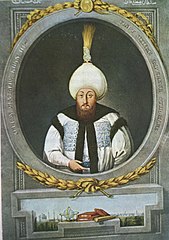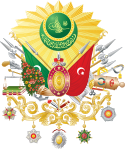Mustafa III
| ||
 | ||
 Tugra Mustafy III | ||
 | ||
| Sułtan Imperium Osmańskiego | ||
| Okres | od 1757 do 21 stycznia 1774 | |
| Poprzednik | Osman III | |
| Następca | Abdülhamid I | |
| Dane biograficzne | ||
| Dynastia | Osmanowie | |
| Data urodzenia | 28 stycznia 1717 | |
| Data śmierci | 21 stycznia 1774 | |
| Ojciec | Ahmed III | |
| Dzieci | Selim III | |
Mustafa III (arab.: مصطفى الثالث) (ur. 28 stycznia 1717 – zm. 21 stycznia 1774) – sułtan Imperium Osmańskiego w latach 1757-1774.
Był synem sułtana Ahmeda III. Był wielkim reformatorem państwa Osmanów. Przeprowadził reorganizację armii i artylerii. Założył sieć akademii wojskowych, których adepci zgłębiali nauki matematyczne, nawigację i inne nauki ścisłe.
Naruszenie terytorium tureckiego przez oddział Kozaków, ścigających konfederatów barskich i spalenie Bałty oraz rozpoczęcie przez Katarzynę II dławienia konfederacji barskiej, zmusiło władcę do wypowiedzenia Rosji wojny 25 września 1768. Zakończył ją traktat w Küczük Kajnardży.
Mustafa III był obiektem drwin ze strony Woltera, który w listach do Katarzyny II, określił go jako "grubego i ignoranckiego"[1].
| ||||
Przypisy
- ↑ BBC NEWS | Entertainment | Record sum for Voltaire letters, news.bbc.co.uk [dostęp 2017-11-25].
Media użyte na tej stronie
Every sultan of the Ottoman Empire had his own monogram, called the tughra, which served as a royal symbol. A coat of arms in the European heraldic sense was created in the late 19th century. Hampton Court requested from the Ottoman Empire a coat of arms to be included in their collection. As the coat of arms had not been previously used in the Ottoman Empire, it was designed after this request, and the final design was adopted by Sultan Abdul Hamid II on 17 April 1882.
Tughra (i.e., seal or signature) of Mustafa III, Sultan of the Ottoman Empire (1757-1774). An explanation of the different elements composing the tughra can be found here.
Autor: Buho07, Licencja: CC BY-SA 3.0
Ottoman Imperial Standard, Late 19th and early 20th Century. Each Sultan had his own Tughra.




